
Future Directions
Future Directions
Brain Machine Interface
Studies have suggested that as a patient uses a brain machine interface, the brain begins to accept the external device as part of its representation of the human body. User control becomes as natural as movement is for unaffected people. While the most immediate application of this technology is obviously to 
 accommodate for disabilities, whether motor or sensory, the potential future applications of this technology are myriad. The Defense and Advanced Research Project Agency (DARPA), is particularly interested in this technology, and has invited proposals which are “far reaching in their implications, innovative, and ambitious in their goals”. Once brain signals are extracted from a subject, the external device to be controlled may be located anywhere if the signal is sent via the internet. This would allow remote control of equipment which would potentially be much more fully integrated into the operator. In handling explosive or hazardous material, for instance, one could remain safely distanced from the material while working with it. Perhaps someday, robotic soldiers will be controlled telekinetically by trained operators on the other side of the country, ensuring that their lives are safe, even in combat.
accommodate for disabilities, whether motor or sensory, the potential future applications of this technology are myriad. The Defense and Advanced Research Project Agency (DARPA), is particularly interested in this technology, and has invited proposals which are “far reaching in their implications, innovative, and ambitious in their goals”. Once brain signals are extracted from a subject, the external device to be controlled may be located anywhere if the signal is sent via the internet. This would allow remote control of equipment which would potentially be much more fully integrated into the operator. In handling explosive or hazardous material, for instance, one could remain safely distanced from the material while working with it. Perhaps someday, robotic soldiers will be controlled telekinetically by trained operators on the other side of the country, ensuring that their lives are safe, even in combat.


Another future direction will be the use of robotic prostheses not as substitution for lost or damaged parts, 

 but rather for enhancement of human ability. This could entail improving an existing mechanism, such as providing high resolution eyesight by feeding zoom video signal into the visual cortex. This technique could also be used to provide users with a sixth sense. For instance, a chemical sensor integrated into brain machine interface could allow one to sense its presence just as naturally as one would smell any fragrance. These applications, once the realm of science fiction, are now legitimate goals for research groups around the country.
but rather for enhancement of human ability. This could entail improving an existing mechanism, such as providing high resolution eyesight by feeding zoom video signal into the visual cortex. This technique could also be used to provide users with a sixth sense. For instance, a chemical sensor integrated into brain machine interface could allow one to sense its presence just as naturally as one would smell any fragrance. These applications, once the realm of science fiction, are now legitimate goals for research groups around the country.




Brain Machine Interface
by Matt Lincicum





